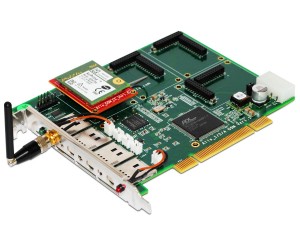** This post is cross-posted on www.greenfieldtech.net **
Honestly, this is something I should have already done a long time ago. About 4 months ago, Allo.Com approached us (GreenfieldTech) to write a review about some of their products. After they agreed to the terms – mainly that they we’ll publish our findings, good or bad – we had to move offices, so everything kind’a went into limbo. Last week, finally, we got around to start reviewing the hardware. We currently started with 2 products, the Allo.COM GSM card (http://www.allo.com/gsm-card.html) and the Allo.Com MegaPBX (http://www.allo.com/megapbx-line.html).
As Eric is still evaluating the MegaPBX, we’ve decided to publish our findings regarding the GSM Card for Asterisk.
Hands on the product
 So, the product itself is nicely packaged – in terms of the electronics involved. I’ve examined the soldering quality, and it would appear that it provides a fairly consistent 60% coverage of soldering, which is fairly acceptable for a card of this scale and quality. One thing I didn’t like was the usage of external wires, however, as this is not the first time I’ve seen that, I can accept it. The card itself is available in 2 form factors, so in general, the “hands on” evaluation passes nicely.
So, the product itself is nicely packaged – in terms of the electronics involved. I’ve examined the soldering quality, and it would appear that it provides a fairly consistent 60% coverage of soldering, which is fairly acceptable for a card of this scale and quality. One thing I didn’t like was the usage of external wires, however, as this is not the first time I’ve seen that, I can accept it. The card itself is available in 2 form factors, so in general, the “hands on” evaluation passes nicely.
Installation
“Patches? Patches? We don’t need to stink’n Patches!” – I admit it, there is nothing I hate more than patching DAHDI drivers (Old OpenVox Style) or adding some 3rd party middleware for DAHDI to make things work (Sangoma). This card takes a slightly higher road. Yes, you are required to have the Asterisk (I do mean Asterisk) source code available. However, it will compile the “channel driver” and an internal resource, very much like the SIP channel – not requiring you to patch Asterisk or DAHDI at all – so in that respect – KUDOS !
To be honest, it took me about 2 days to get the card running, but I was at fault – well, not completely. While the compilation of a “native asterisk” channel driver is a wonderful idea, the documentation kind’a sucks. They still have milage to go with that, however, after contacting their very professional and helpful support staff – it was compiled at ease.
Operation
One thing to get used to – this card is slower, and I do mean much slower, than a normal analog card. The reason isn’t the card, it’s the GSM network. It takes about 10-30 seconds for the card to become fully active, mainly due to the fact that the SIM cards need to register with the GSM network. Once fully active, it will present a channel type GSM, which operates very much like its DAHDI analog equivalent.
The Fire Test
How the hell do you test a card? you make it work really hard – and I do mean hard. So, in order to do so, I’ve created the below Asterisk dialplan:
[from-ipphone]
exten => _X.,1,Set(TIMEOUT(absolute)=${RAND(600,7200)})
exten => _X.,n,Answer()
exten => _X.,n,Wait(${RAND(10,30)})
exten => _X.,n,Dial(GSM/2/050808XXXX,120,R)
exten => h,1,Originate(Local/111@playback-loop,exten,from-ipphone,1111,1)
[playback-loop]
exten => _X.,1,Answer()
exten => _X.,n,Wait(1)
exten => _X.,n(loop),Playback(demo-congrats)
exten => _X.,n,goto(loop)
This dialplan is designed to create random length calls, with a random waiting period between calls. I then issued the following command from the dialplan, to kick it off:
noc*CLI> channel originate Local/111@playback-loop extension 222@from-ipphone
The above will start dialing over and over and over again. My test was really simple, generate X number of calls from my Asterisk host, receive X number of calls on my other SIP gateway. Calls will traverse the GSM network, always playing back the same message and information.
Final Result
Ok, so the test I devised was fairly harsh, specifically due to the fact that I left it running for 5 days !
My origination gateway had originated over 1000 calls in 5 days, sorry to say, only 500+ calls were accepted at the other side. Primary reason appears to be GSM network related and not card related – so it’s hard for me to attribute the result to a specific issue. However, in general, the card performed as I more or less expected it to perform.
Who should use this card?
If you plan to build a GSM gateway – this card isn’t for you, you need something with a bit more control and variability. For a mobile office or as a cellular backup to your PRI line in the office, this will make a nice addition, at a reasonable price range.